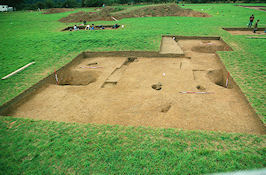
Figure 20: Gateway looking into enclosure with the butt ends of both sides of the outer ditch visible and one side of inner ditch beyond (1977)
Commentary on the Site Description (2008)

Figure 20: Gateway looking into enclosure with the butt ends of both sides of the outer ditch visible and one side of inner ditch beyond (1977)
Three post-pits (0007, 0009 and 1009) formed a row just within the inner edge of the inner ditch. Post-pit 0007 had a post-impression in its base, and the central post-pit 0009 was of a similar shape with a clear and deep post-pipe, while the other post-pit, 1009, also exhibited a post-pipe. The central post-pit had been cut by a smaller one (1005).
Two stone concentrations (1016 and 1018) were set centrally in the area between the four ditch terminals. They were not associated with postholes, but a further concentration lay over a small oval post-pit (1017). These may represent a surfacing of the gateway entrance, though their limited extent made their precise function uncertain.
Three small postholes (0006, 1046 and 1045) were set to the west of 0009/1005 and 0007 and 1009 respectively. Two further post-pits were aligned with the outer (eastern) edge of the outer ditch: 1015, central to the entrance gap, deep and stone-packed (Fig. 21), contained a trapezoidal-sectioned post-pipe, and 1011, near ditch-terminal 1013, had probably held a post at its western end but was not stone-packed.
The interpretation of these features, in the absence of stratigraphic links between them, has to rely on structural patterning, spatial relationships and functional considerations. Several of the post-pits were sufficiently deep and/or well packed with stones to justify the conclusion that a substantial timber structure (or structures) stood in this area. Their position indicated a gate (or gates). Three alternative interpretations of these features are given below.
| Scheme 1: | Post-pits 0009 and 0007 represent a two-post, single-portal gate in Period 3.1. Post-pit 1009 cannot belong to this period since any passage between it and 0009 would be blocked by inner ditch terminal 1012. 0009 is replaced (still in Phase 3.1) by 1005. There is no positive evidence for post replacement in 0007, but the similarity in plan to the composite feature 0009/1005 may suggest that this replacement took place.
In Period 3.3, with the outer ditch in place, a new single-portal gate using posts set in pits 1011 and 1015 might be suggested. However, a simple gate using these oddly placed posts could not close the gap between the outer ditch terminals. In this scheme no new outer gate is, therefore, postulated for Period 3.3. |
|---|---|
| Scheme 2: | As Scheme 1 in Period 3.1 but in Period 3.3 post-pit 1005 is paired with 1009, and supersedes 0009 and 0007. This constitutes a two-post single-portal gateway for the Period 3.3 palisade, similar to the Period 3.1 gate but immediately to the north of it. For this scheme, feature 0008 is considered to be part of the Period 3.3 palisade. The two outer ditch posts (1011 and 1015) form an off-centre symbolic or decorative portal in front of the true gate. |
| Scheme 3: | As Scheme 1 for Period 3.1, but 1009, 1005 and a post replacement in 0007 (suggested in Scheme 1) form a twin-portal, three-post gate in Period 3.3. Post-pits 0006, 1045 and 1046 are perhaps for braces behind the gateposts, although 1045 is poorly placed to fulfill this function. The positions of 1011 and 1015 are taken to be to the north of an inferred third post-pit near ditch terminal 1014, obscured by the earlier Smith excavation. A third post-pit in this position would make possible a more symmetrical arrangement between the ditch terminals, which might be reconstructed as a replacement of the first gate, or as an additional outer gate, or perhaps as a symbolic or decorative gate in front of the inner Period 3.3 twin-portal gate. In this scheme feature 0008 is not considered part of the Period 3.3 palisade. |
Scheme 3 accounts for more of the evidence and may in consequence be preferred, though it relies partially on missing evidence and so must remain unproven.
© Internet Archaeology/Author(s)
URL: http://intarch.ac.uk/journal/issue28/3/3.2.3.6.html
Last updated: Wed July 21 2010